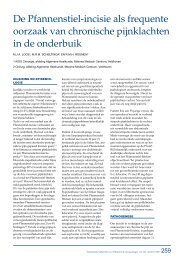Surgical management of chronic inguinal pain syndromes - Liespijn
Surgical management of chronic inguinal pain syndromes - Liespijn
Surgical management of chronic inguinal pain syndromes - Liespijn
Create successful ePaper yourself
Turn your PDF publications into a flip-book with our unique Google optimized e-Paper software.
Diagnostic pathwayTreatment modalitiesIncisional <strong>pain</strong> after Pfannenstiel procedure> 3 monthsYes, nerve blockade (10 cc lidocain)Significant<strong>pain</strong> reductionPeripheralneuropathiccause:(Neuroma/nerveentrapment)Transient <strong>pain</strong>reduction aftera nerve block?Repeat nerveblock (+ corticosteroids)Neuropathic <strong>pain</strong> symptomatology?- Sharp, stabbing, burning- Neurophysiological abnormalities- Trigger point at lateral corner(s)No <strong>pain</strong>reductionPersistent <strong>pain</strong>reduction aftera nerve blockNo, evaluate nonneuropathiccauses andtreat them accordingly:- Lymphoma/ lipoma- Incisional hernia- Cutaneous endometriosis- Musculotendinous- Diffuse scar <strong>pain</strong>- Intra-abdominal pathologyCNS sensitization?- Pain team/anaesthesiologist- Drugs: antidepressants,anti-epileptics, gabapentin- Alternative treatmentoptionsPATIENT AND METHODSA retrospective database search was performed extracting all consecutive patients <strong>of</strong>the Máxima Medical Center (Veldhoven, The Netherlands), who were treated for neuralgia<strong>of</strong> the iliohypogastric and/ or ilio<strong>inguinal</strong> nerve following a Pfannenstiel incisionsince 2000. All medical charts were reviewed for <strong>pain</strong> history, physical examination,additional tests, co-morbidities (defined as endometriosis and lumbosacral radicularsyndrome) and previously received <strong>pain</strong> treatments. Patients were excluded if otherknown causes <strong>of</strong> <strong>pain</strong> such as cutaneous endometriosis were suspected.Treatment algorithm 12All patients were evaluated according to a standard algorithm (figure 2). If <strong>pain</strong> <strong>of</strong>neuropathic origin was suspected, patients received a nerve block using a local anaestheticinto the trigger point. A substantial but temporary <strong>pain</strong> reduction led to a repeatnerve block also using corticosteroids. If these nerve blocks did not result in long-term<strong>pain</strong> reduction, patients were <strong>of</strong>fered a neurectomy <strong>of</strong> the affected nerve (ilio<strong>inguinal</strong>and/or iliohypogastric). This procedure was performed in day-care setting under spinalor general anaesthesia by general surgeons specialized in groin and abdominal wall<strong>pain</strong> pathology (RR and MS). Prior to operation, the responsible nerve was localized bymarking the skin overlying the trigger point. A portion <strong>of</strong> the scar was incised andlateralized if deemed necessary. The overlying subcutaneous tissue and external obliquefascia were dissected and the nerve was identified and removed up to the anteriorsuperior iliac spine (figure 3). For haemostatic purposes nerve endings were cauterised.In an attempt to prevent to recurrent fibrotic encasement the proximal nerve end wasburied in healthy muscular tissue. Nearly all removed specimens underwent pathologicalexamination (figure 4).QuestionnaireBetween September 2007 and November 2007 all treated patients received a questionnairethat was composed <strong>of</strong> parts <strong>of</strong> previously published <strong>pain</strong> studies 13-15 . The followingitems were assessed: <strong>pain</strong> reduction (expressed in a 5-point Verbal Rating Scale andpercentages), complaints associated with sexual activities, perceived complications,overall satisfaction 14 , and current need for <strong>pain</strong> medication.Long-termineffective?NeurectomyRESULTSFigure 2 Diagnostic and therapeutic algorithm for neuropathic post-Pfannenstiel <strong>pain</strong>.From January 2000 to September 2007 twenty-seven women presenting at the surgicaloutpatient department were diagnosed with neuralgia following a Pfannenstiel incision.During the standard workup 5 patients attained long-lasting <strong>pain</strong> relief with a single112 Chapter 8<strong>Surgical</strong> <strong>management</strong> <strong>of</strong> <strong>inguinal</strong> neuralgia after a low transverse Pfannenstiel incision 113





